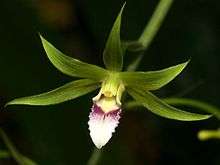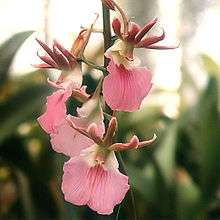Eulophia
Eulophia, commonly known as corduroy orchids,[2] is a genus of about two hundred species of flowering plants in the orchid family, Orchidaceae. Most Eulophia orchids are terrestrial but some are deciduous while others are evergreen. They either have an underground rhizome or pseudobulbs on the surface and those species with leaves have them on the end of a fleshy stem. The flowers are arranged on a thin flowering spike, the flowers having sepals which are larger than the petals. The genus is widely distributed but most species are found in Africa and Asia, usually growing in shady places with grass or shrubs in forests.
| Eulophia | |
|---|---|
 | |
| Eulophia euglossa | |
| Scientific classification | |
| Kingdom: | Plantae |
| Clade: | Tracheophytes |
| Clade: | Angiosperms |
| Clade: | Monocots |
| Order: | Asparagales |
| Family: | Orchidaceae |
| Subfamily: | Epidendroideae |
| Tribe: | Cymbidieae |
| Subtribe: | Eulophiinae |
| Genus: | Eulophia R. Br. nom. cons.[1] |
| Species | |
| Synonyms[1] | |
Description
Orchids in the genus Eulophia are mostly terrestrial herbs with either an underground rhizome or pseudobulbs on the surface. The only two epiphytic species occur on Madagascar. Many species have no leaves, but when leaves are present they are long and narrow, sometimes pleated. The flowers are borne on a flowering stem which sometimes appears before the leaves with a few to many flowers. The flowers in some species are small but others have large, showy flowers in a wide range of colours. The sepals are usually larger than the petals but the labellum has three lobes and a spur or pouch at its base.[2][3][4][5][6]
Taxonomy and naming
The genus Eulophia was first formally described by John Lindley in 1821 and the description was published in The Botanical Register. Because Robert Brown had previously used the name Eulophia in describing Lissochilus speciosus, and the name of that species was changed to Eulophia speciosa, Brown is the accepted author of the name. "Eulophia" is derived from the Ancient Greek words eu meaning "good", "well" or "true"[7]:373 and lophos meaning "mane", "crest", "comb", "tuft" or "ridge",[7]:238 possibly referring to the labellum callus of some species.[5]
Distribution and habitat
Orchids in the genus Eulophia are distributed in shady rainforests or in open scrub or woodland in the tropics and subtropics of Africa, India, Asia, Queensland, and the Americas, although most are found in Africa. Many can survive the dry season through their large bulbous ‘corms’. Some species, such as Eulophia petersii, have adapted to very arid environments and are among the few orchids to have truly evolved desert living species.
Use in horticulture
In the frost-free, semi-arid areas of Southern California, many Eulophia species, such as E. macra, E. petersii, E. plantaginea, and E. speciosa, can be grown outdoors year-round in well-drained pots with cactus/succulent potting mix (although E. speciosa prefers being grown in pure white sand), as long as they are given ample light through the winter and a drier winter resting period. Warmer growers, such as E. pulchra and possibly even the extremely rare and difficult E. cucullata (the foxglove orchid), can probably be grown outdoors in the warmer south areas of Florida and Hawaii, also. The generally large, underground, fleshy rhizome indicates a sympodial growth habit, and this makes Eulophias fairly easy to divide and propagate, provided the grower is gentle.
Species
Gallery




 Eulophia nuda
Eulophia nuda
References
- "Eulophia". World Checklist of Selected Plant Families (WCSP). Royal Botanic Gardens, Kew.
- Jones, David L. (2006). A complete guide to native orchids of Australia including the island territories. Frenchs Forest, N.S.W.: New Holland. p. 358. ISBN 1877069124.
- "Eulophia R.Br. ex Lindl". African Orchids. Retrieved 26 October 2018.
- "Eulophia". Pacific Bulb Society. Retrieved 26 October 2018.
- "Eulophia". Trin Keys. Retrieved 26 October 2018.
- Shrivastava, Rahul J. (2004). "Range extension of Eulophia flava (Lindl.) J.D.Hook. (Orchidaceae) in India". Selbyana. 25 (1): 23–26.
- Brown, Roland Wilbur (1956). The Composition of Scientific Words. Washington, D.C.: Smithsonian Institution Press.
External links
- Dressler, S.; Schmidt, M. & Zizka, G. (2014). "Eulophia". African plants – a Photo Guide. Frankfurt/Main: Forschungsinstitut Senckenberg.
| Wikimedia Commons has media related to Eulophia. |